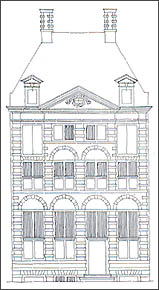The Rembrandthuis
click here to visit the official Rembrabthuis website

Rembrandt's house as it appears today.
After living and working in various rented houses, Rembrandt contracted to buy the house later known as the Rembrandthuis in January 1639 for 13,000 guilders. It tumed out to be a terrible investment. The house had been built in 1606 and had been owned by the wealthy Pieter Belten of Antwerp (1565-1626). He had enlarged it at the rear, and had a gallery built in the inner courtyard. In 1627, his children called in the architect and painter Jacob van Campen (1595- 1657) to carry out further modernization, which included the present facade. Belten's children lived in grand style as if they were nobility. However, while the rebuilding was going on, the elite moved en masse from the old, mediaeval city centre to the new district rising along the fashionable Herengracht and Keizersgracht canals. The price of housing around Sint Anthonisbreestraat plummeted, and when Belten's children decided to sell in the 1630s they could find no takers at the sum they were asking, and the house remained on the market for years.
Meanwhile, Rembrandt must have been looking for a workshop suitable for him to work on his commission for The Nightwatch, among other paintings, and which would reflect his social standing. Many of the houses were sold off cheaply to ]ewish merchants, but Rembrandt paid the full price for his. It was not a happy omen.
The house had been built on very marshy soil too soon after the site had been prepared. The earth used to raise the land bedded down too much, with the result that the houses in the neighborhood began to experience severe subsidence. Shoring up the foundations and repairing the damage cost a great deal of money. When Rembrandt's neighbor decided to raise his house in 1653, Rembrandt refused to make it a joint project, despite the fact that they shared a party wall. He was presented with the bill for this all the same. The truth was that he could not afford to do so. Moreover, he had stopped paying the installments on his house in 1649, and he was also presented with a bill for those in 1653. It was the prelude to his bankruptcy.

Reconstruction of the
Rembrandthuis in Rembrandt's
day. The house was raised
to its present heigth in 1661.
Rembrandt produced many of his works in this fashionable town house in Amsterdam. Purchased by the artist in 1639, when he was 33, it proved to be the scene of personal tragedy: his wife and three of his children died here. The house became a financial burden, and in 1660 Rembrandt was forced to move. A new owner added the upper story and roof, giving it the appearance it still bears. In 1911 the Dutch movement made it a Rembrandt museum preserving it both as a shrine of a revered national artist and as an imposing example of 17th Century Dutch architecture.
from the Rembrandthuis website:
The house where Rembrandt lived between 1639 and 1658 is a museum: Museum het Rembrandthuis or the Rembrandt House Museum. The building was constructed in 1606 and 1607 in what was then known as the Sint Anthonisbreestraat. The street did not come to be called the Jodenbreestraat until later. The house was built on two lots in the eastern part of the city. Many rich merchants and artists settled in this new part of town. The house can clearly be seen on a bird’s eye view map dating from 1625. It is a substantial two-storey dwelling house with a stepped gable. In about 1627-28 the house was drastically remodelled. It was given a new façade, a triangular corniced pediment—the height of modernity at the time—and another storey was added. The reconstruction was probably overseen by Jacob van Campen, who was later to make his name as the architect of Amsterdam Town Hall (now the Palace in Dam Square).


